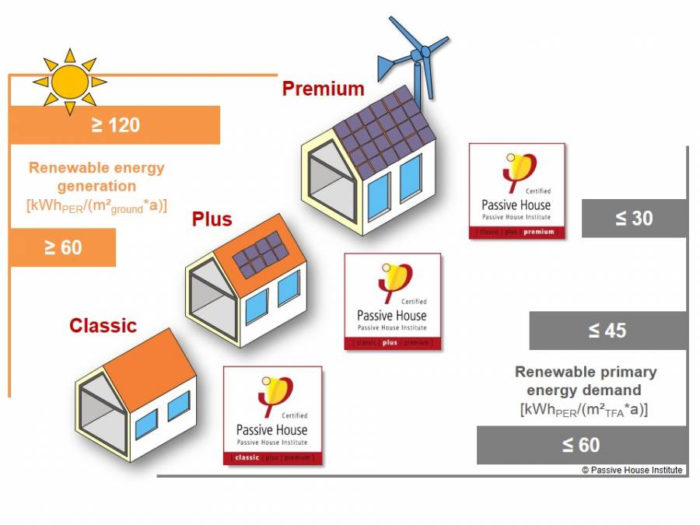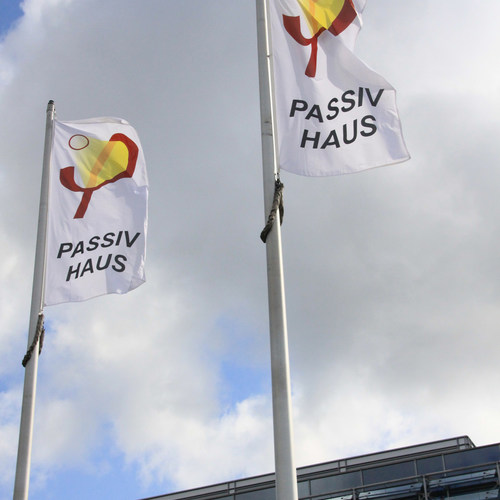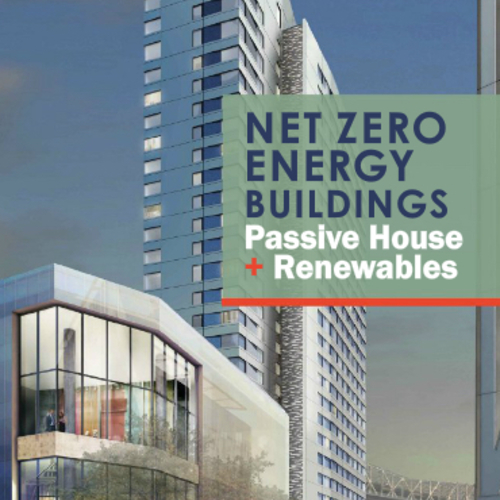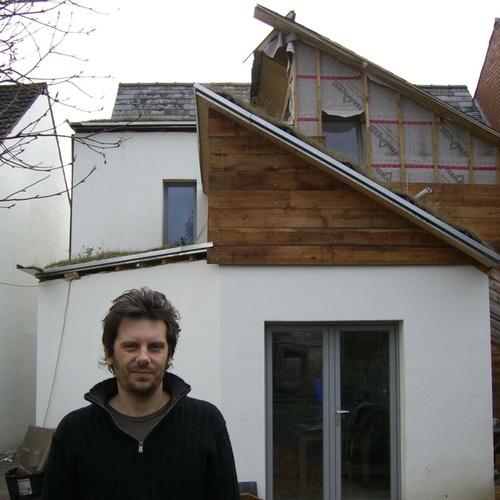
Image Credit: Passivhaus Institut
Germany’s Passivhaus Institut has created two new levels of compliance for certification that for the first time set minimums for renewable energy production as well as new limits on how much energy a building can consume.
The changes are rolled into a new version of the Passive House Planning Package (PHPP), the modeling software that designers use in designing Passivhaus structures, and will go into effect with its release later in April.
While parts of the existing standard are unchanged, there are two new classes of Passivhaus buildings. “Plus” buildings must be able to produce at least 60 kilowatt hours of electricity per square meter per year (kWh/m2/year) and consume no more than 45. “Premium” buildings will be required to produce at least 120 kWh/m2/year while using no more than 30.
A “classic” Passivhaus designation means the building consumes no more than 60 kWh/m2/year. No on-site energy production is required.
Energy production requirements are based on the footprint of the building. Energy consumption limits are based on the total floor area of the building.
For all classes of buildings (Classic, Plus, and Premium), The Passivhaus Institut defines both energy consumption and production as “renewable primary energy demand” (PER), which is electricity produced from a wind turbine or photovoltaic (PV) panels, for example, and not energy produced from non-renewable sources, such as coal.
The changes are an attempt to quantify the type and amount of energy buildings use as renewables become a more important part of the global energy mix, and as Europe heads toward a near-net zero standard for new construction by the start of 2021.
A new way of accounting for energy use
Several of the familiar requirements of the Passivhaus standard apply to all three building categories. For example, certified buildings may not use any more than 15 kWh/m2 of energy per year for heat. Nor has there been a change to the airtightness requirement, which is 0.6 air changes per hour at a pressure difference of 50 pascals.
Requirements for energy production, and the accounting method for the amount of power that’s consumed, however, are brand new.
“The energy supply structure worldwide is transitioning from fossil energies to renewable sources at an encouragingly rapid pace,” Jessica Grove-Smith of the Passivhaus Institut wrote in an email. “Currently existing assessment methods for the energy impact of buildings are, however, all based on the old supply system, only taking into account non-renewable primary energy as [an] efficiency indicator.
“Energy supplied from renewable sources is effectively treated [by some programs promoting net-zero-energy buildings] as free energy that can be used without constraint,” she continued. “In practice, however, renewable primary energy sources are not infinitely available due to space and cost restraints.”
PER takes into account storage losses as well as losses in generation and transmission for renewable energy sources. Fossil fuels are no longer part of the picture.
Built into the new planning software
“They are using a world of 100% renewables, essentially,” Ken Levenson, co-president of the North American Passive House Network, said in a telephone interview. “What they see, which I think is correct, is a future of renewable energy. The grid is going to be renewable. It has to be, and our buildings have to be optimized for that future. And they need to be measured according to that future.”
To make an accurate accounting of energy use, Levenson said, Passivhaus has broken consumption down into five categories, or “baskets”: plugs loads (appliances and lighting), hot water, heating, cooling, and dehumidification.
“Each of those baskets of energy use has a different relationship with renewable energy production,” he said. “For air conditioning, where you have hot summer days and are producing the maximum PV electricity, you have relatively small losses. In winter, when you have heating demand peaking you don’t have renewables [especially solar electricity] available, so you’re relying on storage capacity and the losses associated with that.
“So they assign multipliers based on the total mix of renewables being produced and your mix of using the energy,” he said. “You get these numbers built into the PHPP. This is your heating multiplier, this is your cooling multiplier.” These different multipliers, he added, are the PER factors.
Any given locale — Boston, Chicago, Los Angeles — will not only have a climate “data set” but also a mix of renewable energy sources.
“Renewables may make up only 10 percent of a region’s power generation today,” he said, “but the calculation, for the sake of ‘future proofing’ makes it 100 percent — the fossil fuels are gone from the equation.”
At the same time, the new PHPP will include a value for non-renewable energy consumption.
“In order to be able to assess the building’s environmental impacts in today’s energy supply context,” Grove-Smith wrote, “the PHPP will continue to include the non-renewable primary energy evaluation based on the national/regional energy supply structure.”
“What they are doing is providing a PER source energy based on an optimized 100% renewable future, and providing the traditional source energy based on national averages of energy fuel mix today,” Leveson said. “So you get the traditional number as well as the future-proof sustainability assessment number.”
Not necessarily “net zero” buildings
Judging by the requirements for production and consumption of energy for the “plus” and “premium” categories, it looks as though both would be net-zero energy buildings.
But, Levenson said, the demand numbers are actually for total floor area of a building, and the production is for the footprint of the building. A single-story “plus” building might well be net-zero, but a two-story design might not be, nor would a four-story “premium” building.
“With a single-story building it would be very easy for a Passivhaus building to be an energy-positive building,” he said. “When you add stories to the building, on a per-square-foot basis it would be harder and harder to net out the usage of the building. But it’s less important than knowing that we’ve optimized the square footage of the earth that the building is occupying.”
Confusing? Yes.
“I’m just learning it, too,” Levenson said. “Everybody’s just dipping their feet into it.”
The upcoming Passivhaus Institut conference in Leipzig, Germany, April 17 and 18 will offer more details and case studies showing out the system is used. In addition, the principles behind PER are described in a lecture by Grove-Smith delivered earlier this year at the International Passive House Conference. Another lecture, by Dr. Benjamin Krick, goes over the details of compliance for the “plus” and “premium” categories.
Impact on the North American market
The Passivhaus standard is one of two similar building certification systems in use in North America (the other being administered by the Passive House Institute US, or PHIUS, which also has revised its standard). Neither accounts for more than a very small percentage of total new construction.
But Levenson still thinks the new Passivhaus standard will have an impact as buildings become increasingly energy-efficient and renewables play a larger role.
“I think it’s going to have a huge effect,” Levenson said. “One of the big questions is this whole push toward net zero, what does it mean to be net zero, what does it mean to have a renewable energy economy, and this is really the first thing that I’ve seen that pulls it together from both ends and shows a pathway forward where renewables are really supporting a low energy, high-efficiency basis.
“We’re at the dawn of this paradigm,” he continued. “The market is completely immature in any number of ways, but I think the bigger vision and full integration across the spectrum of how these buildings operate and how they fit into the global energy mix is going to be very powerful. Whether it’s New York, or Vermont, or Maine, or California, it’s going to have a deep impact.”
Weekly Newsletter
Get building science and energy efficiency advice, plus special offers, in your inbox.















One Comment
Bringing PER info home to North America
Thanks for this article, Scott. There's a large delegation of North American Passive House practitioners attending the upcoming international conference in Leipzig, later this month. (http://www.passivhaustagung.de/en) We'll all be bringing more information back home on its calculation and local applicability to share with our various regions. (Join us at the 5th Annual NAPHN Dinner in Leipzig to meet the full North American contingent: http://www.naphnetwork.org/events-schedule/announcements-1/naphndinnerattheinternationalpassiveconferenceleipzig.)
There's a high probability that a special workshop on PER will be included at the NAPHN15 Conference in Vancouver, on October 1-2 (http://naphn15.canphi.ca/.) I hope to see you there.
Log in or create an account to post a comment.
Sign up Log in